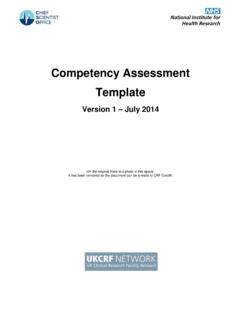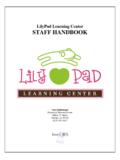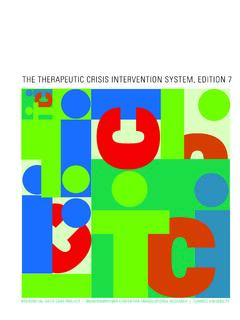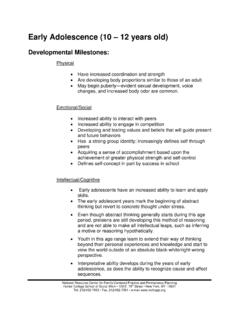Transcription of Single Competency Assessment Template
1 Competency Assessment Template Version 1 July 2014 On the original there is a photo in this space. It has been removed so the document can be e-mails to CRF Cardiff. Competency Assessment Template Version 1 July 2014 Copyright 26 June 2014 The UKCRF Network Competency Assessment Template Project Group - part of the UKCRF Network Education & Training Group Permission granted to reproduce for personal and education use only on the condition that authorship of the UKCRF Network Competency Assessment Template Project Group is acknowledged. Commercial copying is prohibited. Chair of the UKCRF Network Competency Assessment Project Group and contact for this document: Kornelia Hathaway Education & Training Manager NIHR/Wellcome Trust Clinical Research Facility, Box 127 Cambridge University Hospital NHS Foundation Trust Cambridge, CB2 0QQ, United Kingdom Tel: +44 (0) 1223 596058 Email: Acknowledgements The UKCRF Network Competency Assessment Template Project Group gratefully acknowledges the input of all individuals who contributed to the development of this Template including: UKCRF Network Strategic Management Team UKCRF Network Education Group UKCRF Network Lab Managers Workstream Contents Page 1 Introduction to the Competency Assessment Template 1 Why do we have this document?
2 1 What is the Competency Assessment Template ? 1 The boundaries of the Competency Assessment Template 1 Introduction to using the Competency Assessment Template 2 Training 3 Roles and responsibilities 4 Some explanations about Assessment , feedback and record keeping 5 2 Template for Single Competency Assessment 6 3 Template for Multiple Competency Assessment 10 4 Examples of a populated Competency Assessment Template 17 Preparation of Blood Films 17 Measuring Adult Height with Portable Leicester Stadiometer 21 5 Guidance notes for populating and using the Competency Assessment Template 26 6 References 29 1 Introduction to the Competency Assessment Template Why do we have this document? Providing high quality research requires a trained and competent workforce (ICH GCP 1996).
3 One of the ways of validating staff training is to carry out a Competency Assessment (EdCaN 2008, Epstein & Hundert 2002). Often the Competency assessments have to be written from scratch because there is none available that matches the activity which has to be assessed. The UKCRF Network Education Group were tasked by the UKCRF Network Lab Managers Workstream to create Competency documentation that could be adapted for the assessement of laboratory skills. It became clear at an early stage that there was value in having a generic Competency Assessment Template . Subsequently, the Education Group established a project group, the Competency Assessment Template Project Group, to explore and create a generic Competency Assessment Template that could be populated for any relevant activity that required Competency Assessment . The literature search for this project yielded a plethora of specific Competency Assessment documents in a range of vocational education settings, for example: Canadian Society of Respiratory Therapists (2011), NHS Health Education North West (2013), the University of North Carolina (2012).
4 However, it appeared that there had not been any work carried out to create a nationwide generic Template to document evidence of competence for clearly defined practical tasks undertaken by clinical research staff . With no existing generic Template we could reuse, we agreed to develop our own, resulting in the UKCRF Network Competency Assessment Template . What is the Competency Assessment Template ? The Competency Assessment Template (CAT) presented here by the UKCRF Network Education Project Group is a tool that can be utilised in the workplace of clinical research. Its purpose is to provide a recommended structure which may be populated by staff who have to write a Competency Assessment for a given activity in Clinical Research. The boundaries of the Competency Assessment Template For the purpose of this document a definition of Competency has been adapted from the Competency Framework for Clinical Research Nurses ( Competency Framewok Group 2011): The ability to demonstrate the application of knowledge, understanding, practical and thinking skills to achieve effective performance in a practical skill.
5 The CAT has been designed for those instances where a Competency Assessment is required and where there is no existing documentation in place. Where there is already a Trust or Board policy that determines how Competency is assessed it is recommended that these are used if they are available and appropriate for the task. 2 Miller s (1990) pyramid model for assessing clinical Competency (see Figure 1) is widely referred to in the literature on Competency Assessment . The CAT has been designed to allow Assessment at a level approximating to the shows how or level 3 of Miller s pyramid (Miller 1990). At this level the member of staff has full knowledge and comprehension of the procedure, shows that they can discuss the principles in detail, can perform the procedure competently without supervision or assistance, but recognises their own limitations and seeks appropriate advice when necessary.
6 The CAT is to be used in conjunction with any professional code of conduct relevant to the staff member and in accordance with ICH GCP. All staff remain accountable for their professional conduct at all times during training, supervised practice, Competency Assessment and in practice following sign-off. It is recognised that Standard Operating Procedures (SOPs) assist in reproducibility and consistency of performance of tasks (Amare 2012). However, SOPs do not ensure that competence has actually been achieved. This does not mean that all SOPs require to be followed up by a Competency Assessment . Such a decision will be made locally and will take into consideration factors such as risk and quality assurance. Please note the CAT should not be confused with a Competency Framework, for example, that for Clinical Research Nurses ( Competency Working Group, 2011).
7 Such frameworks provide a broadly defined combination of competences that mark out an entire staff group in the clinical research field. In contrast the CAT was designed so it could be populated and serve as an Assessment document for a well-defined task or activity which a member of staff is required to undertake in Clinical Research. Introduction to using the Competency Assessment Template For ease of use the project group decided to issue the CAT in the following two forms: Single Competency Assessment to be used for tasks which require a Single Competency Assessment prior to sign off Multiple Competency Assessment to be used for tasks which require multiple Competency assessments prior to sign off The CAT is a blank Template designed to be populated with the various components that together make up the specified task for which a member of staff has to be assessed, for example, this could be the task of being competent in using a Gilson Pipette.
8 These components will fall into the categories of knowledge, skills and behaviour. Figure 1: Miller GE (1990) 3 We have provided two examples where a CAT has been populated with the wording for a Competency Assessment . One is for Preparation of Blood Films and the other is for Measuring Adult Height with Portable Leicester Stadiometer. During the draft stages of this project it has proved very useful to look at such an example while trying to understand the instructions for the CAT. If the person populating the Template is not the designated expert in the subject, the expert must authorise the content of the Template . A system recording expert authorisation should be implemented locally. Ideally the CAT will be produced alongside an SOP for the same task, but the CAT may on occasion be produced as a stand-alone document. The components of the Competency should reflect the content of any related SOP.
9 It is recommended that the populated Assessment document is reviewed at least every 2 years or when there is a significant change in practice or a change in the related SOP whichever is earlier. It is suggested that staff members will not need to be reassessed immediately following the production of a new SOP and CAT but should be made aware of the change. In the case of significant change in practice, appropriate training should be given to staff members who have already been signed off as competent and arrangements for reassessment made as appropriate. Dependent on the task, it may be sufficient to complete a Single Competency Assessment in order to be signed off as competent, use of the centrifuge. For a more complex task it may be necessary to complete multiple Competency assessments prior to being signed off as competent, venesection, receiving informed consent.
10 Detailed guidance has been created outlining how to populate the Template prior to distribution and how to use the Template during Assessment (see pages 26-29). Training The Competency Assessment Tool (CAT) has been designed to aid Competency Assessment following appropriate training and supervised practice. It is not a training document, though evidence of training may be required as part of the Competency Assessment as evidence that a Competency component has been achieved. Adequate training should be sourced as appropriate to the task. Should a period of supervised practice be required following initial training, this can be supported by another member of staff who has already been assessed and signed off as competent in the task. A member of staff will only be considered safe and competent to perform the task autonomously once they have been assessed and signed off as competent by an assessor.








